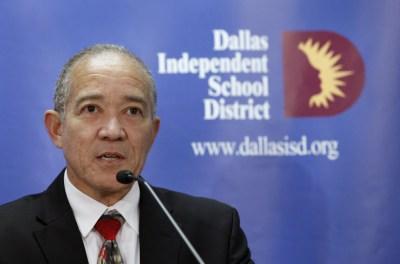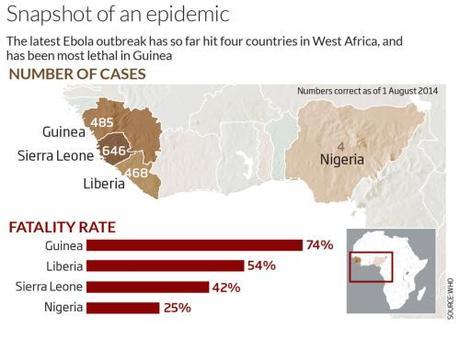This is a follow-up of Steve’s post this morning on the first confirmed case of Ebola in the U.S.– a Liberian national who recently came to Dallas, Texas from Nigeria. Both Liberia and Nigeria are among the West African countries stricken by the terrible epidemic that has a 60-90% fatality rate.
The patient is identified by Liberian health officials and The Associated Press as Thomas Eric Duncan. He has been kept in isolation at Texas Health Presbyterian Hospital of Dallas since Sunday.
The latest:
Duncan may have infected a second man. Even worse, Duncan had come into contact with five children in five separate Dallas schools over the weekend. Altogether, Dallas health officials said today that they believe Duncan had come in contact with at least 12 to 18 people when he was experiencing symptoms and, therefore, was infectious. So far, none of his contacts has been confirmed to be infected.

USA Today reports, Oct. 1, 2014, that the director of Dallas County Health and Human Services, Zachary Thompson, said “there may be another case that is a close associate with this particular patient. So this is real. There should be a concern, but it’s contained to the specific family members and close friends at this moment.”

The AP reports, Oct. 1, 2014, that Dallas Independent School District Superintendent Mike Miles said that the five students were in school this week after possibly being in contact with the man over the weekend. But Miles says the students are showing no symptoms and are now being monitored at home. As an added precaution, Miles says additional health and custodial staff will be at the five schools the students attend.
Although the first Ebola man may have infected a second individual as well as five students, Zachary Thompson continues to insist that the public isn’t at risk because health officials have the virus contained.
Meanwhile, the New York Times reports, Oct. 1, 2014, that the infected man, Thomas Eric Duncan, arrived in the United States on Sept. 20 aboard a commercial airliner. Officials said Duncan had shown no symptoms of the disease while on the flight and that he had posed no threat to other passengers.
Duncan worked at a shipping company in Monrovia, Liberia, but had just quit his job, giving his resignation in early September, his boss said. Duncan’s neighbors in Liberia said he had gotten a visa to the United States and had decided to go. He lived alone, but has family in the United States.
Authorities also said an early opportunity to put Duncan in isolation, limiting the risk of contagion, may have been missed because of a failure to pass along critical information about his travel history. Duncan had sought medical help but was sent home, two days before he was finally admitted into the hospital.
- Friday, Sept. 19: Duncan boards flight from Liberia.
- Saturday, Sept. 20: Arrives in Dallas to visit family.
- Wednesday, Sept. 24: Duncan develops symptoms of Ebola, including fever.
- Friday, Sept. 26: Seeks care at hospital but is sent home.
- Sunday, Sept. 28: Placed in isolation at Dallas hospital.
- Tuesday, Sept. 30: Lab confirms Duncan has Ebola.
Unlike Director of Dallas County Health and Human Services Zachary Thompson, Texas Gov. Rick Perry is taking matters very seriously. He said at a news conference today: “This case is serious. This is all hands on deck.”
Health officials are continuing to track down other people who might have been exposed to Duncan after he began showing symptoms, and will monitor those individuals every day for 21 days — the full incubation period of the disease. Most people develop symptoms within 8 to 10 days. As a patient becomes sicker and the virus replicates in the body, the likelihood of the disease spreading grows.
Health officials insist the disease is only spread by people with symptoms, such as diarrhea or vomiting. But a 2012 Canadian research study casts doubt on that, showing that the Ebola virus could be transmitted by air across two animal species.

Meanwhile, The Daily Caller reports the happy news that 13,500 people from the Ebola-stricken countries of Sierra Leon, Guinea and Liberia have visas to visit the United States, according to federal data.
The data don’t show how many of those people are already in the United States, but visitors from those countries should be excluded until they can show they’re free of Ebola, said Jessica Vaughan, policy director at the Center for Immigration Studies, a group that pushes for low-scale immigration.
Under current policies, only people with obvious Ebola symptoms are excluded by border officials. But a person can be infected with the disease, and not show any symptoms, for up to 21 days.
All of which led Dr. Jesse L. Goodman, a former Food and Drug Administration chief scientist and top infectious disease specialist who’s now a professor of medicine at Georgetown University Medical Center, to say that given the exposure of several people to the Ebola virus by patient zero Duncan, it’s likely that many more will be infected.
As reported by the Washington Examiner, Dr. Goodman warns that while Americans shouldn’t panic, it’s best to prepare for the worst. He said in a statement:
“If anyone did not agree before, bringing the epidemic in Africa under control is an absolute emergency and requires a massive effort and global commitment now long overdue. This is a matter not just of preventing death and suffering in Africa, but, as this case brings home to the U.S., of global safety and security.
While there is an expectation that this case, and likely future ones, can be contained, it is important not to be overconfident and to continuously, now and in the future, reexamine both how the virus is behaving and also the public health and medical response to see what can potentially be improved.
It is critical for hospitals and health care workers everywhere to be sure they are alert, obtain travel histories and, if there is any question at all it could be Ebola, contact CDC and, while sorting things out, act to isolate a sick patient returning from an epidemic area.”
Goodman suggested that travel be limited to the area in West Africa where the epidemic is raging. “If less people traveled, risks may be reduced, and active follow-up and education of travelers could also be facilitated.”
Just wait till the U.S. soldiers — including 700 of the 101st Airborne Division who are heading to Liberia in late October — whom President Ebola is sending to “combat” the pandemic in West Africa, come home . . . .
H/t FOTM’s DCG and Anon
See also:
- Ebola out of control: dogs eating Ebola corpses in Liberia
- Can out-of-control Ebola epidemic hit America?
- Obama signs Executive Order for detention of Americans showing signs of ‘respiratory illness’
~Eowyn

